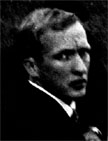![]()
Written
by C.S. Inghean![]() Early
Years
Early
Years![]() 1960's
1960's![]() 1970s
1970s![]() 1980s
1980s![]() 1990
- Present
1990
- Present
 |
1960's
The 1960's catapulted Barnes' career into full momentum and the turbulence of this era mirrored Barnes' personal struggles.
In 1961, He was awarded the William and Norma Copley Foundation Prize for Painting. After being awarded a Fullbright Grant to study english portraiture during the same year, Barnes and his wife boarded and sailed the QE2 to live and study in London.
Attending the University of London, Slade School of Art 1961-1963, Barnes tutored under Sir William Coldstream and Francis Bacon. Francis Bacon was on the board of the London Arts Council and through him Barnes had access to the London Theatre's inner workings which became a huge influence in Barnes' figurative painting style.
Living on the Thames, in Hampton Court, Barnes was immersed in the London pop scene and though this genre never had an influence on his work he befriended pop artists such as Richard Hamilton, Richard Smith, Peter Blake and Joe Tilson.
On November 11th 1962, Barnes' first child a daughter was born in Kingston Upon the Thames.
In 1963, Barnes received the Guri Siever award from the Art Institute of Chicago and a renewed Fullbright Grant. Barnes returned to the U.S. to accept a visiting artist position at the Kansas Art Institute, Kansas City, where he met Thomas Hart Benton, and Andrew and Dahlia Morgan.
Barnes had an affinity for the American West due to a stay in New Mexico when he was a teenager. With Kansas City as a base he enjoyed traveling and exploring Native American reservations, and was fascinated with the art, mysticism and lifestyle of the native peoples.
The following year in 1964 Barnes accepted a professors position at Indiana University in Bloomington, on tenure year track.That November 21st, Barnes' second child a son was born.
At I.U.'s fine art department Barnes taught graduate and under graduate painting along with colleagues Jim McGarrell and William Bailey. Newly settled in Bloomington, Barnes for the next 6 years painted diligently and showed often at Frumkin's galleries between New York and Chicago, a remarkable accomplishment due to the fact that Barnes' marriage at this point had become deeply troubled and disruptive. It can probably be said that the constant prodding by Frumkin and the artists' ambition enabled this progression. During this period Barnes made the acquaintance of Max Clarac in New York and in 1967 he exhibited at the Gallerie du Dragon, Paris, France.